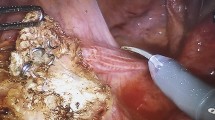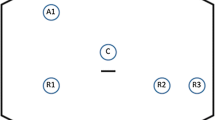Abstract
Background
For patients with rectal prolapse undergoing Ventral Rectopexy (VR), the impact of prior prolapse surgery on prolapse recurrence is not well described.
Purpose
The purpose of this study was to compare recurrence rates after VR in patients undergoing primary and repeat rectal prolapse repairs.
Design
This study is a prospective cohort study.
Methods
IRB-approved prospective data registry of consecutive patients undergoing VR for full-thickness external rectal prolapse between 2009 and 2015.
Main outcome measures
Rectal prolapse recurrence was defined as either external prolapse through the anal sphincters or symptomatic rectal mucosa prolapse warranting additional surgery. Preoperative and postoperative morbidity and functional outcomes were analyzed. Actuarial recurrence rates were calculated using the Kaplan-Meier method.
Results
A total of 108 VRs were performed during the study period. Seventy-two were primary and 36 repeat repairs. Seven cases were open, 23 laparoscopic, and 78 robotic. Six cases were converted from laparoscopic/robotic to open. In 63 patients, VR was combined with gynecological procedures. There were no statistical differences between primary or recurrent prolapse for the following: demographics, operative time, concomitant gynecologic procedures, complications, blood loss, and graft material type. Length of stay was longer in patients with a history of prior prolapse surgery (p = 0.01). Prolapse recurrence rates for primary repairs were reported at 1.4, 6.9, and 9.7% and for recurrent prolapse procedures 13.9, 25, and 25% at 1, 3, and 5 years (p = 0.13). Mean length of follow-up was similar between groups. Time to recurrence was significantly shorter in patients undergoing repeat prolapse surgery 8.8 vs 30.7 months (p = 0.03).
Conclusions
VR is a better option for patients undergoing primary rectal prolapse repair.

Similar content being viewed by others
References
Kuijpers HC (1992) Treatment of complete rectal prolapse: to narrow, to wrap, to suspend, to fix, to encircle, to plicate or to resect? World J Surg 16(5):826–830
Formijne Jonkers HA, Draaisma WA, Wexner SD et al (2013) Evaluation and surgical treatment of rectal prolapse: an international survey. Color Dis 15(1):115–119
Tou S, Brown SR, Malik AI, Nelson RL (2008) Surgery for complete rectal prolapse in adults. Cochrae Database Syst Rev 4(4):CD001758
Tou S, Brown SR, Nelson RL (2015) Surgery for complete (full-thickness) rectal prolapse in adults. Cochrane Database Syst Rev 11:CD001758
Hotouras A, Ribas Y, Zakeri S et al (2015) A systematic review of the literature on the surgical management of recurrent rectal prolapse. Color Dis 17:657–664
D'Hoore A, Cadoni R, Penninckx F (2004) Long-term outcome of laparoscopic ventral rectopexy for total rectal prolapse. Br J Surg 91(11):1500–1505
Samaranayake CB, Luo C, Plank AW, Merrie AE, Plank LD, Bissett IP (2010) Systematic review on ventral rectopexy for rectal prolapse and intussusception. Color Dis 12(6):504–512
Gurland B, Alves-Ferreira PC, Sobol T, Kiran RP (2010) Using technology to improve data capture and integration of patient-reported outcomes into clinical care: pilot results in a busy colorectal unit. Dis Colon Rectum 53(8):1168–1175
Varma MG, Wang JY, Berian JR, Patterson TR, McCrea GL, Hart SL (2008) The constipation severity instrument: a validated measure. Dis Colon Rectum 51(2):162–172
Srikrishna S, Robinson D, Cardozo L (2010) Validation of the patient global impression of improvement (PGI-I) for urogenital prolapse. Int Urogynecol J 21(5):523–528
Steele SR, Goetz LH, Minami S, Madoff RD, Mellgren AF, Parker SC (2006) Management of recurrent rectal prolapse: surgical approach influences outcome. Dis Colon Rectum 49(4):440–445
Raftopoulos Y, Senagore AJ, Di Giuro G, Bergamaschi R (2005) Rectal prolapse recurrence study group. Recurrence rates after abdominal surgery for complete rectal prolapse: a multicenter pooled analysis of 643 individual patient data. Dis Colon Rectum 48(6):1200–1206
Senapati A, Gray RG, Middleton LJ et al (2013) PROSPER: a randomised comparison of surgical treatments for rectal prolapse. Color Dis 15(7):858–868
Gouvas N, Georgiou PA, Agalianos C et al (2015) Ventral colporectopexy for overt rectal prolapse and obstructed defaecation syndrome: a systematic review. Color Dis 17(2):O34–O46
Consten EC, van Iersel JJ, Verheijen PM, Broeders IA, Wolthuis AM, D'Hoore A (2015) Long-term outcome after laparoscopic ventral mesh rectopexy: an observational study of 919 consecutive patients. Ann Surg 262(5):742–747 discussion 747-8
Mackenzie H, Dixon AR (2014) Proficiency gain curve and predictors of outcome for laparoscopic ventral mesh rectopexy. Surgery 156(1):158–167
Badrek-Al Amoudi AH, Greenslade GL, Dixon AR (2013) How to deal with complications after laparoscopic ventral mesh rectopexy: lessons learnt from a tertiary referral centre. Color Dis 15(6):707–712
Evans C, Stevenson AR, Sileri P et al (2015) A multicenter collaboration to assess the safety of laparoscopic ventral rectopexy. Dis Colon Rectum 58(8):799–807
Culligan PJ, Blackwell L, Goldsmith LJ, Graham CA, Rogers A, Heit MH (2005) A randomized controlled trial comparing fascia lata and synthetic mesh for sacral colpopexy. Obstet Gynecol 106(1):29–37
Smart NJ, Pathak S, Boorman P, Daniels IR (2013) Synthetic or biological mesh use in laparoscopic ventral mesh rectopexy--a systematic review. Color Dis 15(6):650–654
Buchs NC, Ostermann S, Hauser J, Roche B, Iselin CE, Morel P (2012) Intestinal obstruction following use of laparoscopic barbed suture: a new complication with new material? Minim Invasive Ther Allied Technol 21(5):369–371
Salminen HJ, Tan WS, Jayne DG (2014) Three cases of small bowel obstruction after laparoscopic ventral rectopexy using the V-loc((R)) suture. Tech Coloproctol 18(6):601–602
Sakata S, Kabir S, Petersen D, Doudle M, Stevenson AR (2015) Are we burying our heads in the sand? Preventing small bowel obstruction from the V-loc(R) suture in laparoscopic ventral rectopexy. Color Dis 17(9):O180–O183
Gurland B (2014) Ventral mesh rectopexy: is this the new standard for surgical treatment of pelvic organ prolapse? Dis Colon Rectum 57(12):1446–1447
Author information
Authors and Affiliations
Contributions
BG: Concept, design, data analysis and interpretation, manuscript writing.
MEC: Data collection, data analysis.
BR: Data interpretation, manuscript editing.
MP: Data interpretation, manuscript editing.
TH: Data interpretation, manuscript editing.
MZ: Concept, design, data interpretation, manuscript editing.
Corresponding author
Rights and permissions
About this article
Cite this article
Gurland, B., e Carvalho, M.E.C., Ridgeway, B. et al. Should we offer ventral rectopexy to patients with recurrent external rectal prolapse?. Int J Colorectal Dis 32, 1561–1567 (2017). https://doi.org/10.1007/s00384-017-2858-9
Accepted:
Published:
Issue Date:
DOI: https://doi.org/10.1007/s00384-017-2858-9




